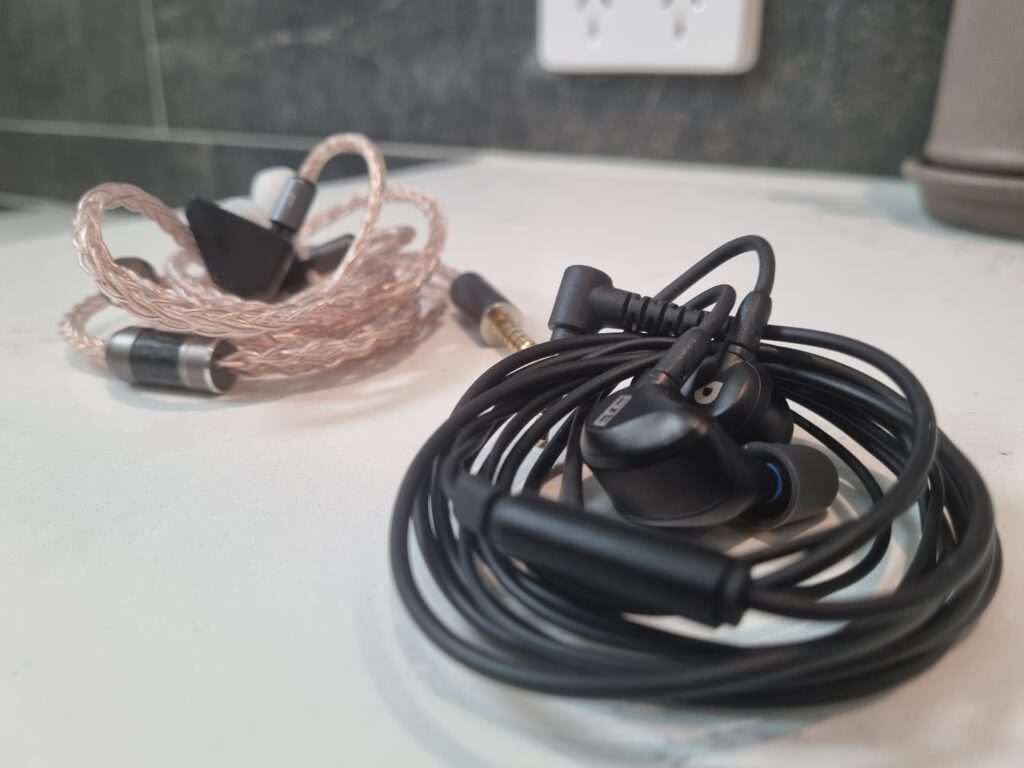Driveability
Etymotic Research’s IEMs each share one thing in common: their rated mechanical impedance figures. The ERX has an above-average rated mechanical impedance of 47 ohms, with 98 dB SPL of sensitivity. At first glance, this might seem like a peculiar design choice by the Etymotic team.
But a higher mechanical impedance allows for more exacting control over the transducers found on either IEM, headphones, or speakers. More control means a tauter, snappier response. And a controlled response leads to less audible distortion or artefacts detracting from music playback. All it needs is driving power to harness its unrealised potential.
Thankfully, most dongle DAC/Amps are more than sufficient to drive the ERX with success, but we’d recommend avoiding “brighter” sounding sources that favour a thinner note weight. Any further suckouts in the lower midrange can exacerbate what can be described as “intensely forward” to the treble-averse.
Comparison

Truthears Hexa
Introduction
The Truthears Hexa is a relatively recent release in the Chi-Fi marketplace, defined by a barrage of new releases on a weekly basis. Allegedly founded by an ex-engineer from the Moondrop brand, Truthears has proven itself a qualified competitor in a multiplicity of price brackets, ranging from the humble $20 (Hola) upwards to the sub-$100 mark.
Today, we’re highlighting the top-end of their current offerings, the Hexa, a futuristic-themed IEM with a multi-driver array boasting four balanced armatures and one liquid crystal polymer (LCP) dynamic driver diaphragm on each channel. Unofficially crowned the “Blessing 2” of the budget arena, the Hexa has swept many fans off their feet with its highly-lauded technical proficiency in spite of its unassuming price.
Priced at $89.99, this may seem like an undeserving comparison purely because of the price differential. However, there are some consistencies between both IEMs that would make for a worthy comparison.
Comparison
The Truthears Hexa’s base sonic signature is defined by a modest V-shaped signature reminiscent of the “Harman-inspired trend” found across the audiophile hobby. Unsurprisingly, the Hexa’s LCP drivers are responsible for reproducing the bass frequencies in the entire mix. The Hexa’s primary focus in the mid-bass and sub-bass divisions is the latter. There’s a visceral rumble that digs deeper with more gusto and body in comparison to the ERXs leaner response. This is to be expected from a dynamic driver, but the Hexa never quite radiates bass aplomb akin to my consumer-friendly tunings.
The Hexa’s midrange actually exhibits base similarities with the ERX, with a slight recession in the upper-mids to ameliorate possible bouts of wonkiness up top. How they differ, however, is the extent of these modifications. The Hexa’s upper-midrange roll-off is perceivable as larger, with less energy in the presence region as it transitions upwards. The Hexa’s treble, while sweet-sounding with reasonable clarity, has a splashy tonality that I would consider an unnatural aberration sabotaging its timbral exactness; a quality the ERX indexes better for.
The Hexa’s technical limitations also begin to rear its head. The ERX’s micro-detailing and raw resolution is definitively better by virtue of its uncontested speeds. Subtle shifts in amplitude, be they soft or sudden, resolves swiftly on the ERX. Soundstaging performance on the Hexa’s exhibits stronger lateral with between the L-R channels, but suffers from not-as-precise layering, with respective audible elements (instruments, voicings etc.) lacking outright definition amongst each other.
The Hexa is still a skillfully tuned IEM with deft capabilities in its immediate price bracket. Nonetheless, it doesn’t quite scale the heights the ERX has reached.
Conclusive remarks

The ERX is a re-interpretation of the Etymotic house sound for a different breed of consumer. From that POV, the ERX has successfully achieved what it sought to achieve, providing audiophiles with a healthy alternative to the fan-favourite ER4 series of professional IEMs.
While there’s no undoing Etymotic’s balanced-armature bass timbre and the dearth in air displacement, The ERX’s nuanced bass cliff soothes these issues with measurable success. And it’s hard to deny the sheer addictiveness of its ultra-resolving midrange and treble sparkle.
If you can overlook the ERXs standard deep insertion depth, the ERX could be the end-game IEM you’re searching for.



